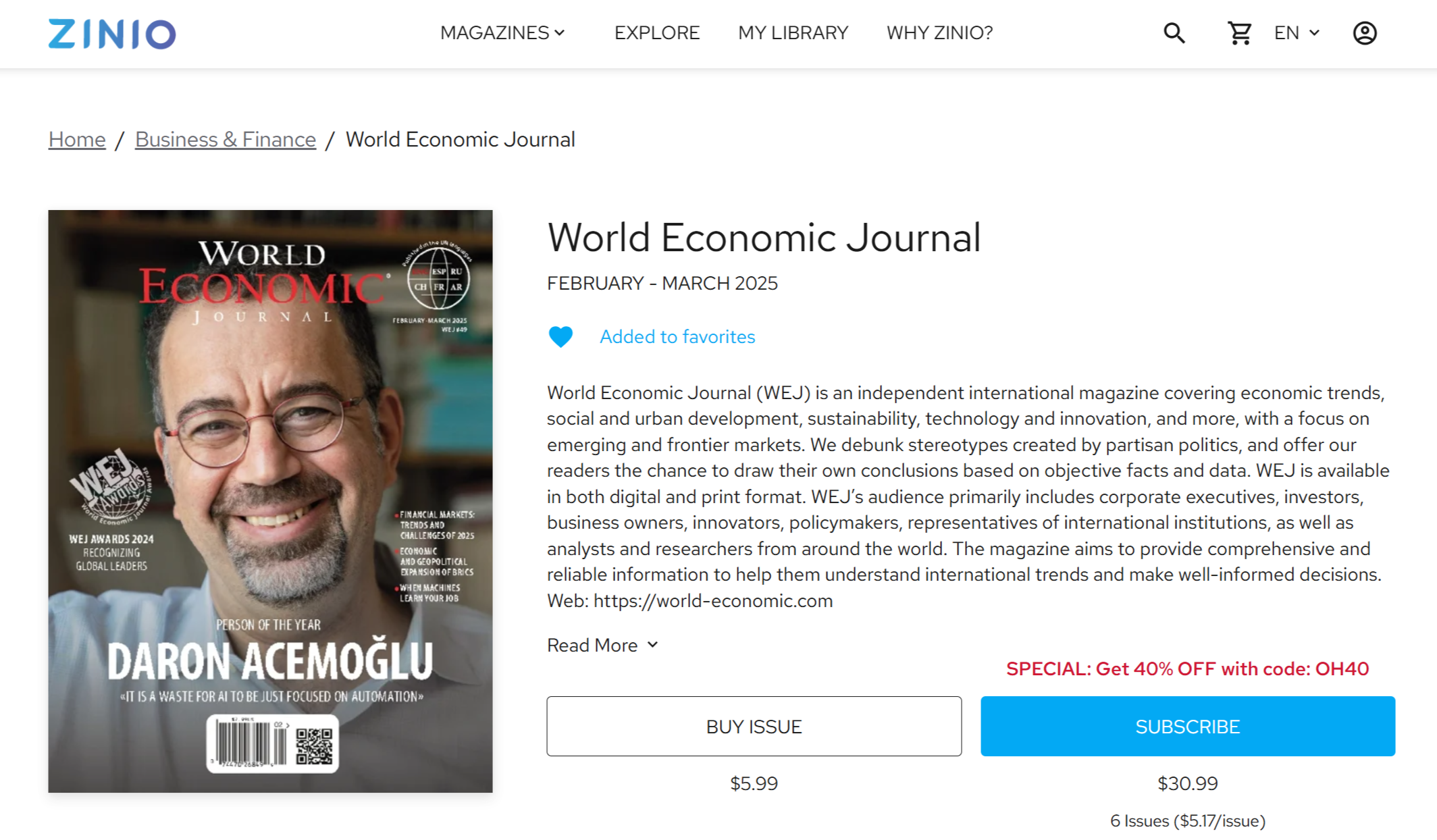Robert Abdullah: First, I’d like to congratulate you and your colleagues, Simon Johnson and James A. Robinson, on winning the Nobel Prize for your work on the formation and impact of institutions on prosperity. In light of your recent comments to the Nobel Committee about the threats to democracy posed by communication infrastructure and social media, I’m curious to know what technological advancements and development models could potentially reverse this trend and strengthen democracy, particularly in countries with weaker institutions.
Daron Acemoğlu: Thank you very much. I’m not sure that we can bank on technological advancements to strengthen democracy. My view is that democratic institutions have to perform better in industrialized nations so that the trend of declining support for democracy is halted and people start having trust in democratic institutions again. This requires more shared prosperity (no group being left behind in the process of economic growth), high-quality public good provision, and better voice for people (so that large segments of the population should not feel excluded from the political process and debates).
In my opinion, much of the declining support for democracy in the United States and Europe is related to the breakdown of shared prosperity, failure of public goods and service provision, and a perception that many people do not have an effective voice. Once democratic institutions start performing better in these countries, I think this will have a demonstration effect, and demand for democracy in nations with weaker institutions will also grow. Of course, at the same time, we have to worry about the use of AI and other tools for repression and surveillance in the hands of authoritarian governments, which will be another factor weakening democracy around the world.
“Much of the declining support for democracy in the United States and Europe is related to the breakdown of shared prosperity, failure of public goods and service provision, and a perception that many people do not have an effective voice.”
Robert Abdullah: In your work, you’ve highlighted how new digital technologies have negatively impacted workers, leading to job displacement and increased corporate power, “shifting the balance of power from labor to capital”. You’ve called for new approaches to technology and policy to ensure that workers benefit from technological advancements. Could you elaborate on the specific policies and institutional reforms needed to mitigate the risks associated with new technologies?
Daron Acemoğlu: My perspective is that technology is always malleable, so choices we make about the development and use of technology determine who wins and who loses from new advances. Digital technologies have negatively impacted workers, because the tech sector and corporations have focused too much on automation. I have argued that we should prioritize creating new tasks for workers using new technologies.
This can have much more empowering impact on labor and also reduce inequality. But such a redirection of technological change will not happen by itself. We need support for new technologies that are more pro-worker and also remove fiscal incentives that encourage too much automation (for example, the fact that there are much lower marginal taxes on capital than labor in the United States and other industrialized nations, which encourages excessive automation). Having a strong labor movement can also help, especially if the leadership of the labor movement focuses on technology and finds strategies to encourage companies and managers to use technology in a way that increases productivity but also helps workers.
“Of course, at the same time, we have to worry about the use of AI and other tools for repression and surveillance in the hands of authoritarian governments, which will be another factor weakening democracy around the world.”
Robert Abdullah: In your 2019 article, ‘The Wrong Kind of AI?’, you noted that the introduction of AI primarily aimed at automating labor-intensive tasks typically leads to job losses, wage stagnation, and increased inequality. However, you also observed that ‘if AI is used to create new tasks and increase human capabilities, the benefits would be more likely shared with labor.’ Given the rapid development of AI tools in recent years, what do you consider to be the most promising directions for using AI to create such new tasks?
Daron Acemoğlu: What I explained above for technologies in general is doubly true for AI. AI is a very flexible technological platform that can be used in many different ways. In my mind, it is a waste for AI to be just focused on automation, because it has the capability to be very useful for workers by increasing their expertise, by enabling them to perform more sophisticated and new tasks, and by improving their training.
For such a change to happen, the tech industry needs to change first. The prioritization of automation is rooted in the business models and the ideology of the tech industry. As you point out, there is very rapid development of AI in recent years, but this is going very much in the direction of automating work and also using AI for manipulative purposes (for example, the attention economy and digital ads). I don’t think this is the most productive use of AI, and the proper mix of regulation and encouragement for new uses of AI could break us out of this cycle.
“It is a waste for AI to be just focused on automation, because it has the capability to be very useful for workers by increasing their expertise, by enabling them to perform more sophisticated and new tasks, and by improving their training”
Robert Abdullah: The recent BRICS summit in Kazan was a significant global event. Several leaders called for urgent reforms to the international financial architecture. For instance, Xi Jinping advocated for expanding the role and capabilities of the BRICS New Development Bank. The summit also discussed the potential for a common BRICS currency. In your view, what are the prospects for developing such economic instruments within the BRICS framework, and what timeline is realistic for their institutionalization?
Daron Acemoğlu: I am not sure that the most important priority right now should be to develop a common BRICS currency. In my mind, there is something much more important for many middle-income countries, including those in BRICS: to make sure that AI does not harm middle-income countries.
I am very worried about the possibility that AI will increase the gaps between rich and poor (and middle income) countries, partly because it will automate a lot of tasks in which middle-income countries specialize. Here, China’s and other BRICS countries’ priorities may differ. China is a leading player in AI, and I’m not convinced that the direction of AI companies in China, like the direction of the AI companies in the United States, are particularly useful for middle-income countries.
Robert Abdullah: Finally, we’d like to hear your thoughts on research into emerging markets, a key focus of the World Economic Journal. What are the most pressing topics in this field right now? Do you find our journal valuable, and what other issues should we explore in our publications?
Daron Acemoğlu: I definitely believe that we need more research into emerging markets, and hence, World Economic Journal plays a very important role. The world is changing fast, and there is a danger that trends in AI, globalization, and geopolitics can adversely affect emerging markets. This is an important topic for research. We also need a more holistic understanding of how emerging markets can best adapt to technological changes.
By Robert Abdullah Editor-in-Chief of World Economic Journal
Stay informed anytime! Download the World Economic Journal app on the App Store, Google Play, ZINIO, Magzter and Issuu.
https://apps.apple.com/kg/app/world-economic-journal-mag/id6702013422
https://play.google.com/store/apps/details?id=com.magzter.worldeconomicjournal
https://www.magzter.com/publishers/World-Economic-Journal
Issue FEBRUARY – MARCH 2025 – World Economic Journal https://www.zinio.com/publications/world-economic-journal/44375



